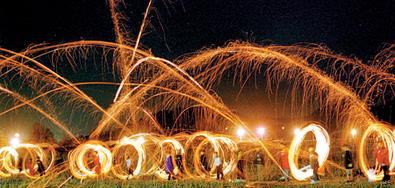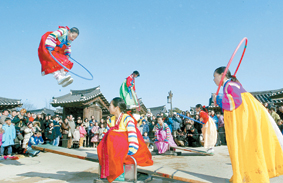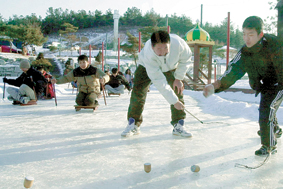Ancient contests involve children of all ages

a large-scale jibulnori

Boys flying shield kites.
One game that has been loved by children since the period of the Three Kingdoms is paengichigi, in which a carved top is spun on icy ground by hitting it with string. Children often stood on the ice looking at whose top spun the longest and which design looked the most dazzling. Paengi is an 18th or 19th century word that derives from pingi, from the early Joseon dynasty, meaning “spin.” The paengi were mainly made of either metal or wood, but children who made their own paengi usually made them with wood.
A similar game is jegichagi, frequently played during the winter (although the game can be played regardless of the season). The objective of the game is to keep the jegi, a top made with synthetic paper that looks like a mini pompom, up in the air as long as possible by bouncing it with one’s foot.
With only a few weeks before the Chinese New Year, kitchens around Korea are bustling as mothers prepare rice cakes for the big day. Children anticipate a new set of clothes, called sulbim, which they receive at the beginning of every new year.

Girls playing neoldduigi
This year, Chinese New Year falls on Feb. 18.
Besides food and new clothes, there are other important elements that make up this holiday in Korea, mainly traditional games that the whole family can enjoy. Yutnori, a kind of western dice game played with four wooden sticks, and neoldduigi, a game for women in which they secure a large wooden seesaw and jump high in the air, are favorite games that have been enjoyed by Koreans for centuries. Yutnori is one of the few games that is still played frequently by families. It consists of just four wooden sticks, so anyone can enjoy it regardless of gender or age. In the past, in rural areas, the game was a way for farmers to test if they could work with their neighbors amicably.
Neoldduigi originated during the Joseon dynasty, an oppressive era for women. The Confucian society of the day did not allow women to walk around freely. The earliest records of this game are from the early Joseon dynasty and, according to some of them, the game was a way for women to have a glimpse of husbands who were in jail. In other accounts, neoldduigi was a way for women to take a look at the world outside the fences surrounding their houses as they jumped high on the see-saw.
A popular and quite picturesque game played by children during this time is kite flying. Although people start flying kites in Korea around early winter, Chinese New Year is the prime date to show off one’s uniquely decorated kite as there are many competitions with prizes for altitude and intricacy.
In “Samguksagi,” a book about the Three Kingdoms Period, written during the 12th century, general Kim Yu-sin used a kite to signify to his people that their kingdom is like a shining comet by ordering his soldiers to burn the end strings, propelling the kite to soar through the sky.
However, a quick reality check reminds us that we are now in the 21st century and this is 2007. Nintendo has become a vintage game for kids.
These days, the main activity during Chinese New Year at a typical household is a gathering for breakfast or lunch with family members. It is rare to see anyone wearing hanbok and even more rare to see anyone engaged in neoldduigi.
“Nowadays, some traditional games like yutnori are still being played in households, but overall, it is rare to see people engaging in these games, especially in big cities,” said Jung Yon-hak, a curator at the National Folk Museum who focuses on folk games.
In the past, before Korea’s industrialization and evolution as a democratic nation, jeongcho, or the period between Jan. 1 and Jan. 15 of the lunar calendar (which includes Chinese New Year and Jeongweol Daeboreum, meaning first full moon) was thought of as a time to quietly reflect upon the past year and prepare for the new. Games, therefore, were played before or after that period.
“As the holidays became official national holidays and started getting commercialized, games such as rope-pulling and yutnori became more prevalent during New Year and Jeongweol Daeboreum (Jan. 15 of the lunar calendar),” said Mr. Jung.
Records of Jeongweol Daeboreum go back to the Three Kingdoms Period, in which people celebrated the full moon and the blessings of light. In this respect, the most traditional game played on this day is jibulnori, in which families, especially males, went to the rice fields, laid out straw and lit it on fire. This was done to kill the mice and insects that might be harmful for the year’s harvest. The game was a competition between villages. The one with the biggest firelight was expected to have the best harvest. With the apartment boom of the 1970s, apartment complexes soon took the place of many fields and farmland. Many apartment buildings in the suburbs banned this game as being dangerous.

A game of paengichigi. [JoongAng Ilbo]
After the winter frost starts to melt, Koreans celebrated Samjit (March 3 of the lunar year). It is a seasonally appropriate holiday giving thanks for spring. Neighbors gather in someone’s backyard and panfry rice cakes decorated with edible flowers. Children would play a game in which they pluck various wild flowers and leaves from the fields, gather them in their hands, criss-cross the bundles and pull until one side breaks. Another springtime game is tuho, in which arrows are thrown towards a large vase in an attempt to get as many inside as possible.
On May 5 of the lunar calendar is Dano, one of the big three holidays in Korea along with Chinese New Year and Chuseok (Korean Thanksgiving). The holiday is celebrated in Korea, China and Japan. May is considered an unlucky month and there are records from the Han dynasty in China that state that it brings many diseases. “Our ancestors played games during Dano that are supposed to strengthen one’s health, such as ssireum [Korean wrestling] and geunedduigi [swing play],” said Mr. Jung.
Especially in the Pyongyang area (now North Korea), ssireum, played by men, and swinging, played by women, was very popular. In the classic Korean novel “Chunhyangjeon,” the main character Lee Mong-ryeong meets his love Chun-hyang while she is on a swing.
During the season when autumn slowly disappears making way for the winter, Koreans celebrate Chuseok (August 15 of the lunar calender). Just like the Thanksgiving celebrated by Americans, this is a day to offer thanks for the year’s harvest. Chu, meaning fall, and seok, meaning evening, refer to a good season in which grains are ripe and the moon is bright and full. As this is a season of harvest, relating to farming and labor, games with cows were popular among men.
Turtle games were popular in the southern part of Gyeonggi province as well as certain parts of North Chungcheong province. Neighbors would pick random stalks and make them into a turtle shell shape. Two people would get inside this shell and with a band following them playing folk music, they would visit houses in their village. In many records, this turtle game is said to symbolize longevity and well-being while others say that the turtles symbolize a “guardian” quality that protects the whole community.
As many of these games originated on small farms, they have gradually disappeared as cities grew. “These games are respectful towards the environment and they represent many aspects of our traditional life. For one, these games are social games. They can’t be played alone. As they immerse themselves in computer games and the Internet, children are isolating themselves more and more,” said Mr. Jung Yon-hak, who is also president of the Korean Traditional Culture Experience School. The school provides programs for children in which they can experience traditional Korean culture.
“It is quite a pity that these games are disappearing but we can’t expect people to give them attention without changing them to fit modern times. Developing yutnori as a computer game will be one example. Also, for things like kite flying and neoldduigi, there should be interesting contests sponsored by the government and cultural organizations,” said Mr. Jung.
By Cho Jae-eun Staff Writer jainnie@joongang.co.kr










with the Korea JoongAng Daily
To write comments, please log in to one of the accounts.
Standards Board Policy (0/250자)